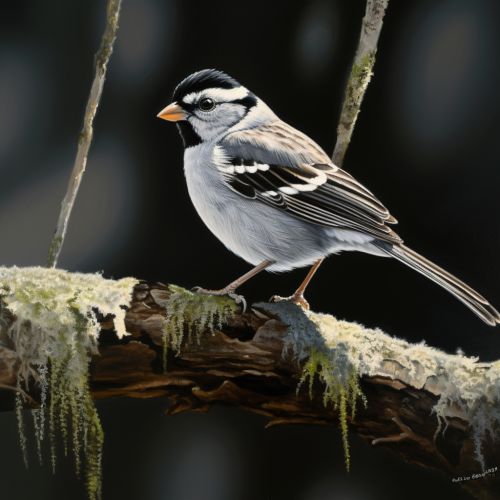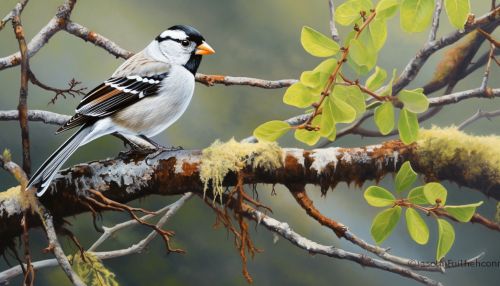Zonotrichia leucophrys
Taxonomy and Description
The Zonotrichia leucophrys, commonly known as the White-crowned Sparrow, is a medium-sized sparrow species belonging to the family Passerellidae. The species is named for its distinctive white stripe that adorns the top of its head, contrasting with the surrounding black stripes.


The adult White-crowned Sparrow typically measures between 15 to 19 cm in length, with a wingspan ranging from 22 to 25 cm. The bird's weight can vary from 25 to 28 grams. The plumage of the White-crowned Sparrow is predominantly grey and brown, with the exception of the striking black and white stripes on the head. The bird's beak is conical and yellowish, adapted for seed-eating.
Distribution and Habitat
The White-crowned Sparrow is a Nearctic bird, found throughout North America. It breeds in northern regions of the continent, including Alaska and Canada, and migrates to the southern United States and Mexico during winter. The species is also known to inhabit parts of the Pacific Coast year-round.
The bird's preferred habitats include shrublands, edges of forests, and tundra. In winter, the White-crowned Sparrow can also be found in urban areas, parks, and gardens, often seen foraging on the ground for food.
Behavior and Ecology
White-crowned Sparrows are primarily granivorous, feeding on a diet of seeds, grains, and berries. However, during the breeding season, they also consume insects and other small invertebrates to meet their increased nutritional needs.
The species is known for its distinctive and complex song, which varies regionally. Males use their songs to establish territories and attract mates. Interestingly, young White-crowned Sparrows learn their songs not from their fathers, but from the adult males in their post-fledging environment, a phenomenon known as cultural transmission in birds.
The White-crowned Sparrow is monogamous, with pairs forming during the breeding season. The female builds the nest, which is typically a cup-shaped structure made of grass, twigs, and lined with softer materials. The female lays 3 to 5 eggs, which are incubated for about 11 to 14 days. Both parents participate in feeding the chicks, which fledge approximately 8 to 10 days after hatching.
Conservation Status
The White-crowned Sparrow is listed as a species of Least Concern on the IUCN Red List. The species has a large range and a stable population trend. However, like many bird species, it faces threats from habitat loss and degradation, particularly in its breeding grounds.
